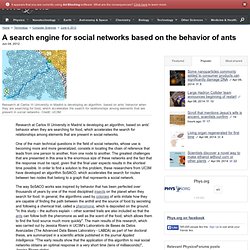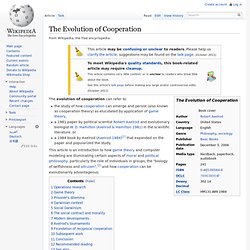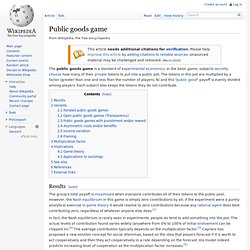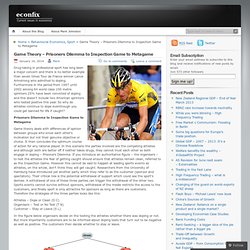

New Gaming. Probability theory. Coordination game. In game theory, coordination games are a class of games with multiple pure strategy Nash equilibria in which players choose the same or corresponding strategies.

Coordination games are a formalization of the idea of a coordination problem, which is widespread in the social sciences, including economics, meaning situations in which all parties can realize mutual gains, but only by making mutually consistent decisions. A common application is the choice of technological standards. For a classic example of a coordination game, consider the 2-player, 2-strategy game, with the payoff matrix shown on the right (Fig. 1). If this game is a coordination game, then the following inequalities in payoffs hold for player 1 (rows): A > B, D > C, and for player 2 (columns): a > c, d > b. In this game the strategy profiles {Left, Up} and {Right, Down} are pure Nash equilibria, marked in gray. Examples[edit] Mixed strategy Nash equilibrium[edit] Coordination games also have mixed strategy Nash equilibria.
What does "the enemy's gate is down" really mean? Hypernerd memes. Game theory. Choice Theory. Rock paper scissors lizard spock spider-man batman wizard glock. During the latest Introducing Design lecture we were presented with a simple problem: how can the age old game scissors paper rock be improved.

The obvious issue with this game is that with only three choices (paper covers rock, rock breaks scissors and scissors cuts paper), the game often ends in a tie, so naturally, the likelihood of a game ending in a tie could be decreased by adding more options players can choose. One such “improved” version is paper scissors rock lizard Spock, which many people may know from its appearance in The Big Bang Theory where it is explained by the character Sheldon Cooper.
Aside from the fact that Sheldon invariably chooses Spock, the game starts to become more difficult to play than the original version since it takes more time to explain all the interactions (paper disproves Spock, Spock vaporises rock, etc) than actually playing the game, which makes it less useful as a simple tool to resolve disputes. But why stop at just five options? Can games create an education fit for the future? Imagine a school where playing video games is encouraged during classes and may even replace exams.

A new educational programme uses SimCity to test children on vital problem-solving skills. Video games usually get in the way of homework. GlassLab, however, is a collaboration between educators and technologists. Uniting commercial game studios and educational groups the aim is to embrace gaming technology to transform the learning process and make it more relevant to the demands of the 21st Century. Medieval Games in Europe. In exploring the games played in Medieval Europe, we'll just find out that the people of those times were no different from us, as they were fond of public amusements and they did their best to make their time pass agreeably.

In the early Norman times the favorite sports of the Medieval people were bowling, fencing with sword and buckler, the sword dance, and wrestling. At a later period came the Quintain. Ragman Roll. Applying algorithm to social networks can reveal hidden connections criminals use to commit fraud. A search engine for social networks based on the behavior of ants. Research at Carlos III University in Madrid is developing an algorithm, based on ants' behavior when they are searching for food, which accelerates the search for relationships among elements that are present in social networks.

One of the main technical questions in the field of social networks, whose use is becoming more and more generalized, consists in locating the chain of reference that leads from one person to another, from one node to another. The greatest challenges that are presented in this area is the enormous size of these networks and the fact that the response must be rapid, given that the final user expects results in the shortest time possible. In order to find a solution to this problem, these researchers from UC3M have developed an algorithm SoSACO, which accelerates the search for routes between two nodes that belong to a graph that represents a social network. Multiple applications. Neuroeconomics. Neuroeconomics is an interdisciplinary field that seeks to explain human decision making, the ability to process multiple alternatives and to choose an optimal course of action.

It studies how economic behavior can shape our understanding of the brain, and how neuroscientific discoveries can constrain and guide models of economics.[1] Behavioral economics emerged to account for these anomalies by integrating social, cognitive, and emotional factors in understanding economic decisions. Neuroeconomics adds another layer by using neuroscientific methods in understanding the interplay between economic behavior and neural mechanisms. By using tools from various fields, some scholars claim that neuroeconomics offers a more integrative way of understanding decision making.[1] Introduction[edit] The Evolution of Cooperation. The evolution of cooperation can refer to: the study of how cooperation can emerge and persist (also known as cooperation theory) as elucidated by application of game theory,a 1981 paper by political scientist Robert Axelrod and evolutionary biologist W.

D. Hamilton (Axelrod & Hamilton 1981) in the scientific literature, ora 1984 book by Axelrod (Axelrod 1984)[1] that expanded on the paper and popularized the study. This article is an introduction to how game theory and computer modeling are illuminating certain aspects of moral and political philosophy, particularly the role of individuals in groups, the "biology of selfishness and altruism",[2] and how cooperation can be evolutionarily advantageous.
Operations research[edit] Public goods game. The public goods game is a standard of experimental economics.

In the basic game, subjects secretly choose how many of their private tokens to put into a public pot. The tokens in this pot are multiplied by a factor (greater than one and less than the number of players, N) and this "public good" payoff is evenly divided among players. Each subject also keeps the tokens they do not contribute. Results[edit] Game Theory – Prisoners Dilemma to Inspection Game to Metagame. Home > Behavioural Economics, Sport > Game Theory – Prisoners Dilemma to Inspection Game to Metagame Drug-taking in professional sport has long been a major concern and there is no better example than seven times Tour de France winner Lance Armstrong who admitted to doping.

Furthermore in the period from 1997 until 2002 among 64 world class 100 metre sprinters 25% have been convicted of doping and this doesn’t include two American sprinters who tested positive this year. Ieee-gwap.pdf (application/pdf Object) Game mechanics for thinking users « Homo Surfens. Game mechanics for thinking users Posted by Pietro Polsinelli on November 9, 2010 · 12 Comments Many software applications and web sites that are not commonly understood as games have some aspect that can be described in gaming terms.

3. Ludic interface. Student experiment in Interface Design developed at UP Valencia. GlassLab Games. Theories of Poker. The Emerging Revolution in Game Theory. The world of game theory is currently on fire. Game Theory. Gamers succeed where scientists fail. Public release date: 18-Sep-2011 [ Print | E-mail Share ] [ Close Window ] Contact: Leila Grayleilag@u.washington.edu 206-685-0381University of Washington. Right on queue. Parrondo's paradox. Seas Labs. SEAS is the Synthetic Environment for Analysis and Simulations engine that enables researchers and organizations to try out their models or techniques in a publicly known, realistically detailed environment, but without the logistical problems associated with actually installing the system in a real firm.
SEAS provides valuable interaction among researchers, between researchers and industrial users, and allows students to practice what is learned through a safe, controlled synthetic environment. EteRNA - Played by Humans. Scored by Nature. Solve Puzzles for Science. The Science Behind Foldit. Foldit is a revolutionary new computer game enabling you to contribute to important scientific research. Gamers beat algorithms at finding protein structures. Today's issue of Nature contains a paper with a rather unusual author list. Read past the standard collection of academics, and the final author credited is... an online gaming community. EteRNA, an Online Game, Helps Build a New RNA Warehouse. EteRNA: Game To Design New Molecules? Hand Games and Mind Games. “Never go against a Sicilian when death is on the line.”
How would do you settle an arbitrary debate if there are no coins on hand to flip, and no straws nearby to pick? Most people will opt for Rock-Paper-Scissors. It’s quick, requires no special equipment and pretty much everyone knows how to play. It’s not the perfect decision making game though.